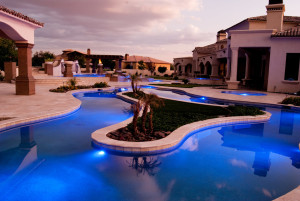Ebbs and flows
When studying flow characteristics relative to the surfaces that contain it, extremely complex dynamic characteristics can be revealed. As a result, system performance can be fine-tuned by way of shaping the vessels. This level of close study has reinforced a handful of commonsense measures that hold true across a spectrum of project types.
Again, looking at the design from a user perspective, if the desire is to simply swim against the current, builders do not have to do much more than place the system in a vessel of an appropriate depth and desired length so that it flows in a straight line at the desired speed. Design issues become more multi-dimensional only when the system is to drive a circuit around the vessel as in the case of a lazy river.

In recent years, lazy rivers in both commercial and residential settings have become far more popular. On the most basic level, a lazy river provides all the benefits of exercising against a current, while at the same time, bathers can turn around and allow themselves to be swept downstream in a controlled environment.
Unfortunately, many lazy rivers are not installed or work properly; mostly those where the builder is attempting to create the flow using standard pumps to push water through long manifolds and returns distributed around the circuit. Despite the builder’s best intentions, all too often the results are dramatically energy inefficient systems that almost inevitably have dead spots.
The trouble in these situations is obvious and infuriating for everyone involved. Imagine being a homeowner who has spent their hard-earned money in hopes of owning their own lazy river, only to find when the big day comes to fire up the system, it does not work.
By contrast, a properly designed lazy river uses both the configuration of the walls and system placement to the greatest effect possible. Some require multiple river current systems to adequately generate flow around the entire circuit, while others work efficiently using only one system. In all cases, there are basic design principles that apply.
Changing the channel
First, and at a minimum, always try to avoid tight radiuses. As described above, builders can either waste tremendous energy when making water change directions or contrastingly focus that energy to enhance the flow.
Next, be aware of where the pool’s ingress/egress will be in the design. There is a tendency in far too many projects to place steps on the corners of lazy rivers. This is a huge mistake because steps in corners will absorb a tremendous amount of energy right at the point where the water should be making a smooth turn. Not only will this disrupt the lazy river effect, it can also create strong turbulence on the steps and, if strong enough, can knock bathers off their feet. This can be a problem that becomes particularly serious with the elderly or small children.
Steps should be placed in areas parallel to the flow, or even better, in widened points in the channel where the water slows down. The issue of step placement is one that can be easily accommodated in the design phase, but dauntingly expensive once the pool is built.
Another key consideration, which applies to lazy rivers as well as simpler vessels with more linear designs, is current speed. How fast the current moves is a product of the system’s flow output combined with the pool’s width, depth, and overall shape.
It is a bit of an oversimplification, but current speed can be related to walking. When the water is moving at 0.6 to 0.9 mps (2 to 3 ft/s), a person flowing downstream with the current will be moving at a slow to medium walking pace. Someone at the side of the pool can easily stroll alongside the bather and have a conversation. At 1.5 mps (5 ft/s), the bather is moving at a rapid walking pace and someone at the side of the pool would probably have to break into a trot to keep up on dry land.
When designing a lazy river, areas with varying speeds can easily be created by simply narrowing or widening the channel, or depending on the current system being used, by adjusting its output.
Finally, it is always helpful to be aware of bather load. In exercise pools designed for a single person working out against the current, it is not an issue. However, in pools that are used by a large number of bathers at the same time—such as a lazy river during a pool party—keep in mind human bodies submerged in water will dramatically absorb energy and reduce the flow. In these scenarios, it makes sense to have a robust system that can be adjusted to increase output to counteract the resistance of all the bathers being pushed by the current.






